WHAT'S NEW ACROSS THE WORLD
Select date in side bar to go a What's
New of previous issues
| What's New ©by
Laif DeMason
The big news as of this writing is the recent
and unexpected death of the longtime Malawi cichlid exporter, Stuart M.
Grant. A killifish hobbyist himself, Stuart began his long career collecting
and shipping Malawi cichlids in the mid 1970s. Stuart sent hundreds of
shipments of cichlids from Lake Malawi to many places around the world
over the last 30 years. He was directly responsible for bringing the joy
of cichlid keeping to many thousands of people, most of whom never knew
the man behind the scenes. Later, he would open his door to any visitor
who wanted to come to Malawi and experience the lake and its unique fauna
first hand. Often, it is difficult to imagine that the people that you
see and talk to regularly will suddenly be gone, never to be able to thank
them for what pleasure they brought into your life. If there is a special
someone who helped by bringing the hobby to you or by enabling you to start
the hobby, then thank that special someone now.
Here’s “what’s new” on the cichlid scene: |
Lake Tanganyika
Wild caught material continues to be harvested from all points around
the lake and shipped out regularly, although at a slower pace. Hobbyists
are still keen on Petrochromis species and the demand is good. Goby cichlid
species are also popular now. Other different groups of Tanganyikan cichlids
are also being sold, seemingly without any focus in popularity.
|
what's new: Lake Tanganyika
|
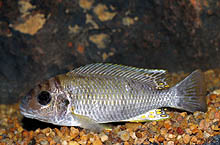
Shipped recently from Burundi, Petrochromis orthognathus
arrived as sub-adults. This variety sports yellow pelvic fins and large
yellow egg spots in both the anal fin and soft ray portions of the dorsal
fin.
|
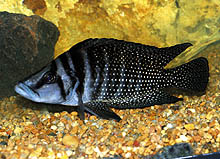
Reportedly collected in southern Congo and sold as
Altolamprologus calvus ink fin. This is the second location of the
so-called “ink fin” variety, originally collected in Nkamba, Zambia.
|
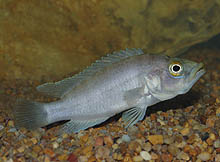
Infrequently collected and exported from Mbita Island,
Zambia, Neolamprologus prochilus is an oddity with a large mouth
similar to Altolamprologus species.
|
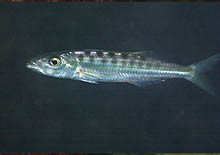
Exported in relatively low numbers, Bathybates
fasciatus is a torpedo shaped predator. Cover your aquarium, as it
can jump! Photo by A. Konings.
|
Lake Malawi
The late Stuart Grant has a large species group of Malawi cichlids named
on his behalf, Aulonocara stuartgranti. This species, one of the
so-called Malawi “peacocks”, has many color forms along the northwestern
Malawi coast as well as the central to southeastern coast along Tanzania,
Mozambique, and Malawi. In many places the fish can be a combination of
blue and yellow body colorations and often the populations gradually change
from blue to yellow, or vice-versa over the miles and miles of coastline.
Thus, as a result, there are many “intermediate” color forms, found between
the well-known populations pictured here.

The very northern form found around the village of
Ngara south to Mdoka, the Ngara “peacock”. This fish has a blue head and
body with a speckling of orange yellow scale flecks across the side of
the body. Photo by A. Konings. |
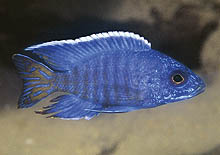
SJust a little farther south near the town of Chilumba,
the Chilumba “peacock”. This fish population is now completely blue with
no yellow body coloration. Photo by A. Konings. |
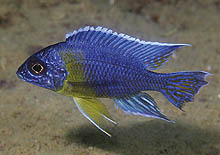
Farther south again is another notable place, Chitimba
Bay. Stuart’s wife, Esther Grant lived here in her younger days. The Maulana
“peacock” found here has a bicolor hue; a blue body divided by a wide vertical
gold yellow bar behind its head. Photo by A. Konings. |
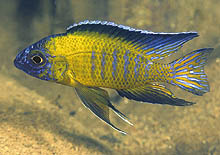
Working our way southward to Usisya, the Flavescent
or Usisya “peacock” is found here and on the opposite side of the lake
in Tanzania as well. This population has a blue face and a completely yellow
body and a black dorsal fin. On the southern end of this population’s range,
the black dorsal fin becomes blue. Photo by A. Konings. |
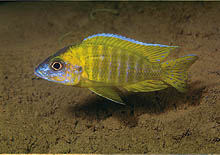
Found very far south on the western coastline, Aulonocara
sp. ”stuartgranti maleri” made its first debut in the USA at the ACA convention
held in Hollywood, Florida in the mid 1970s. This fish was Stuart’s first
big seller and the first completely yellow Malawi cichlid exported, the
Sunshine Yellow peacock. Photo by A. Konings. |
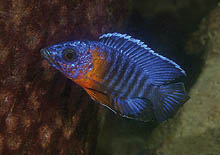
On the Eastern coast around Fort Maguire, Malawi we
find another “peacock” population that was one of the first Aulonocara
varieties exported, the Regal peacock. This fish sports a dark blue body
divided by a red bar behind its head, thus lending to Stuart’s name for
this cichlid, “Red Flush”. Photo by A. Konings. |
Lake Victoria
The recent arrival of new wild caught material from this area has excited
many Victoria cichlid enthusiasts. More collections and exports are expected,
with hopes of novel species yet to come. However, most of the wild species
exported so far are well known varieties. Other related species from different
areas have also been collected and exported.
|
what's new: Lake Victoria
|
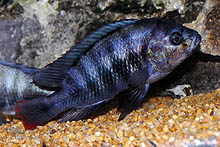
Collected in the Mwanza Gulf, Tanzania, Neochromis
nigricans males becomes coal black when in breeding dress with a bit
of red highlights in the caudal fin. |

Collected in local waters in Burundi and exported
as Haplochromis burtoni, this fish has blue-green body colors with
a bit of orange red behind the gill covers. |
Neotropics
Collecting season began recently in most of South America and should
be in full swing in the next month. Nomenclature changes for many of the
cichlids of this region continue. Scientific names will always be in a
constant state of change as new information becomes evident. Unfortunately,
amateur aquarists often do not realize the “new” species they just bought
on-line is only a well known fish with a new name.
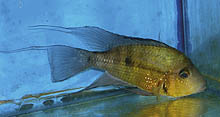
Several species are often available from specialized
breeders of Central American cichlids. Pictured here, Thorichthys pasiones
from Lake Peten, Guatemala. Photo by J. Rapps. |

The leucistic color form of Cryptoheros sp.
‘redpoint honduras’ is new to the trade. It is not the common pink convict
(C. nigrofasciatus), although this related species also produced
a like-colored morph. Photo by J. Rapps. |
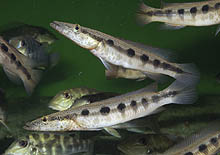
This large pike cichlid, Crenicichla percna,
is infrequently exported from the Rio Xingu, Brazil, depending on the conditions
of each dry season. Photo by O. Lucanus. |
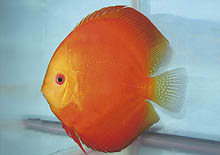
Selectively bred for a solid red coloration, the Red
Melon discus is a new strain and is generally strongly color enhanced to
bring out their spectacular hues. Photo by D. Au. |
Select date in side bar to go a What's
New of previous issues
|















